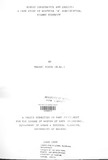| dc.contributor.author | Mbaari, Kinya | |
| dc.date.accessioned | 2014-04-03T08:23:26Z | |
| dc.date.available | 2014-04-03T08:23:26Z | |
| dc.date.issued | 1988-06 | |
| dc.identifier.citation | Master Of Arts (planning),department Of Urban & Regional Planning,university Of Nairobi, 1988 | en_US |
| dc.identifier.uri | http://hdl.handle.net/11295/65804 | |
| dc.description.abstract | This study addresses itself to rural energy constraints and choices in a high agricultural potential area which has a high population density. The predominant source of rural domestic energy in the third World as a whole and in particular reference to the study area is woodfuel. These sources have however diminished leading to poverty and human hardship. The scarcity of woodfuel is evidenced by its commercialization and the greater use of crop residues as woodfuel substitutes. This study has therefore endeavoured first to establish the underlying causes of woodfuel depletion. Second the choices of domestic energy that are available in the study area and the potential for new ones has been examined. Third steps have also been taken to determine what methods can be used to conserve domestic energy in the study area mismanagement of the resources due to farming practices and policies that encourage the clearing of trees to create land for cash crops has led to resource depletion in addition rapid growth in the population has increased environmental stress because of fragmentation of the land (due to land tenure practices), and clearing of trees for human settlement. As a result of the increasing distance to the supplies of fuelwood and charcoal problems related to political economy have increased. Charcoal dealers (usually urban based) get charcoal from other parts of the country and transport it to the study area at high prices. A fourth cause of environmental deterioration has been changes in the climate leading to unpredictable rain patterns. The study has established the possibility of increasing the production of energy through agro forestry and biogas technologies. Besides increasing the energy choices these technologies help to preserve and improve the environment. In addition, solar energy is also a possible source of energy but the high cost of solar equipment is a constraint. The study has also established that energy conservation is possible through the use of improved cookstoves following the research findings planning strategies have been prepared. These have been based on what the people stated were the major problems, lack of land and fuelwood. The three planning strategies are agroforestry systems, biogas technology and domestic energy conservation. Even though the land will not be increased, its productivity will be improved. The policies thus adopted will encourage public participation in the planning and implementation of the strategies. Then through reduced resource depletion and increased availability of domestic energy, rural development will be enhanced. Human hardship and poverty will be reduced to a certain degree. It is expected that the research methodology used in this study can be applied in similar high agricultural potential areas with a high population density and therefore help to alleviate the problem of resource depletion evidenced as woodfuel scarcity. | en_US |
| dc.language.iso | en | en_US |
| dc.publisher | University of Nairobi, | en_US |
| dc.title | Energy constraints and choices: A Case study of Nyathuna 'b' sub-location, Kiambu District | en_US |
| dc.type | Thesis | en_US |

